英语阅读教学教案与活动设计
- 格式:doc
- 大小:223.56 KB
- 文档页数:11
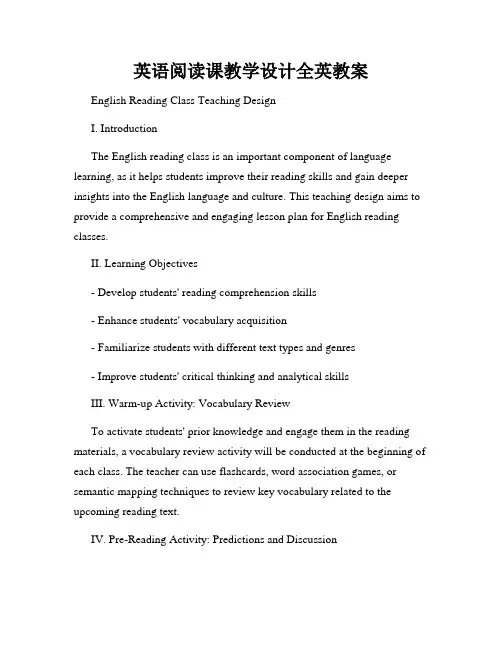
英语阅读课教学设计全英教案English Reading Class Teaching DesignI. IntroductionThe English reading class is an important component of language learning, as it helps students improve their reading skills and gain deeper insights into the English language and culture. This teaching design aims to provide a comprehensive and engaging lesson plan for English reading classes.II. Learning Objectives- Develop students' reading comprehension skills- Enhance students' vocabulary acquisition- Familiarize students with different text types and genres- Improve students' critical thinking and analytical skillsIII. Warm-up Activity: Vocabulary ReviewTo activate students' prior knowledge and engage them in the reading materials, a vocabulary review activity will be conducted at the beginning of each class. The teacher can use flashcards, word association games, or semantic mapping techniques to review key vocabulary related to the upcoming reading text.IV. Pre-Reading Activity: Predictions and DiscussionBefore diving into the main reading passage, students will be encouraged to make predictions based on the title, headlines, or visuals connected to the text. This pre-reading activity stimulates students' curiosity and prepares them for the upcoming reading tasks. Additionally, a short group or class discussion can be facilitated to activate students' background knowledge related to the topic.V. Reading Tasks1. Skimming: Students will read the text quickly to get a general understanding of the content. They will focus on identifying the main ideas, important dates, or key pieces of information within a given time limit.2. Scanning: Students will be given specific questions or statements to locate and retrieve information from the text. This activity aims to develop students' scanning skills, allowing them to find specific details efficiently.3. Detailed Reading: Students will read the text carefully and analyze the structure, style, and language used. They will answer comprehension questions, summarize paragraphs, or identify literary devices. This task promotes critical thinking and trains students to extract meaning from the text.4. Vocabulary Expansion: Throughout the reading process, students will encounter new words or expressions. In this phase, students will be guidedto infer word meanings from context, create personal vocabulary lists, and engage in vocabulary-related exercises such as word collocations, synonyms, or antonyms.VI. Post-Reading Activities1. Discussion and Reflection: After completing the main reading tasks, students will participate in a group or class discussion to share their opinions, thoughts, and reflections on the text. This activity encourages students to express themselves in English and develop their speaking and listening skills.2. Extension Activities: To further explore the text and expand students' comprehension, extension activities can be conducted, such as role-plays, debates, or creative writing tasks. These activities provide opportunities for students to apply the knowledge gained from the reading text in a practical and meaningful manner.VII. AssessmentTo evaluate students' progress and understanding, formative and summative assessments will be implemented. Formative assessments include classroom participation, group activities, and quizzes. Summative assessments may consist of reading comprehension tests, written assignments, or presentations based on the reading texts.VIII. ConclusionThis English reading class teaching design provides a systematic and engaging approach to developing students' reading skills. By incorporating various reading tasks, vocabulary expansion activities, and post-reading discussions, students will not only improve their reading comprehension but also enhance their critical thinking, analytical abilities, and overall language proficiency. This teaching design aims to create an immersive and dynamic learning environment that fosters a genuine love and appreciation for English literature and reading materials.。
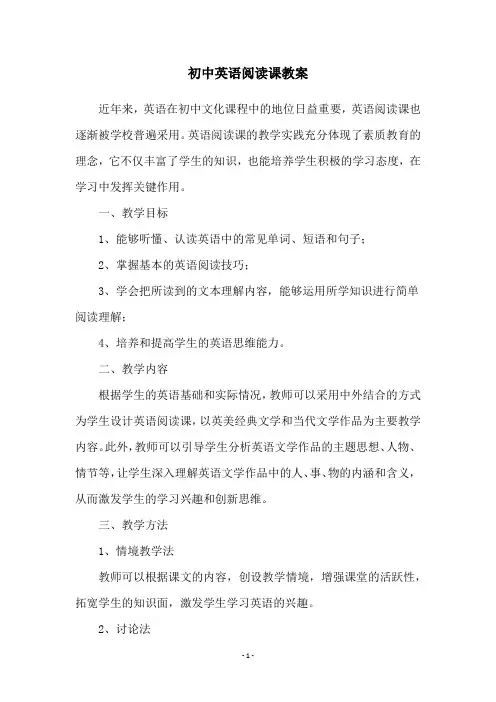
初中英语阅读课教案近年来,英语在初中文化课程中的地位日益重要,英语阅读课也逐渐被学校普遍采用。
英语阅读课的教学实践充分体现了素质教育的理念,它不仅丰富了学生的知识,也能培养学生积极的学习态度,在学习中发挥关键作用。
一、教学目标1、能够听懂、认读英语中的常见单词、短语和句子;2、掌握基本的英语阅读技巧;3、学会把所读到的文本理解内容,能够运用所学知识进行简单阅读理解;4、培养和提高学生的英语思维能力。
二、教学内容根据学生的英语基础和实际情况,教师可以采用中外结合的方式为学生设计英语阅读课,以英美经典文学和当代文学作品为主要教学内容。
此外,教师可以引导学生分析英语文学作品的主题思想、人物、情节等,让学生深入理解英语文学作品中的人、事、物的内涵和含义,从而激发学生的学习兴趣和创新思维。
三、教学方法1、情境教学法教师可以根据课文的内容,创设教学情境,增强课堂的活跃性,拓宽学生的知识面,激发学生学习英语的兴趣。
2、讨论法让学生更好地理解文本内容,培养学生思考能力,激发学生学习英语的热情,掌握重要的知识点,提高学生听、说、读、写的能力。
3、英语教学游戏通过组织各种英语教学游戏,让学生在游戏中操练所学英语,增强学生的英语学习能力,提高学生学习英语的兴趣。
四、教学设计1、课前准备(1)准备相关英语教材,吸引学生的兴趣,让他们对本课有更深刻的理解;(2)熟悉课文内容,以便对学生进行指导;(3)设计出相应的教学活动,以便落实教学目标。
2、课堂教学(1)调动学生学习英语的积极性,激发学生学习的兴趣;(2)用情景教学法给学生呈现英语阅读课教学内容,通过模仿、翻译、改写与演示等多种教学方法,渗透语言知识,培养学生英语思维能力;(3)分组讨论,学习课文;(4)运用英语教学游戏,提高学生综合运用英语的能力;(5)结合情景,进行语言实践活动,激发学生的学习兴趣;(6)当堂测验,辅助学生复习。
3、课后作业让学生通过课后的复习和练习,熟练掌握课文的内容,提高英语的阅读能力。
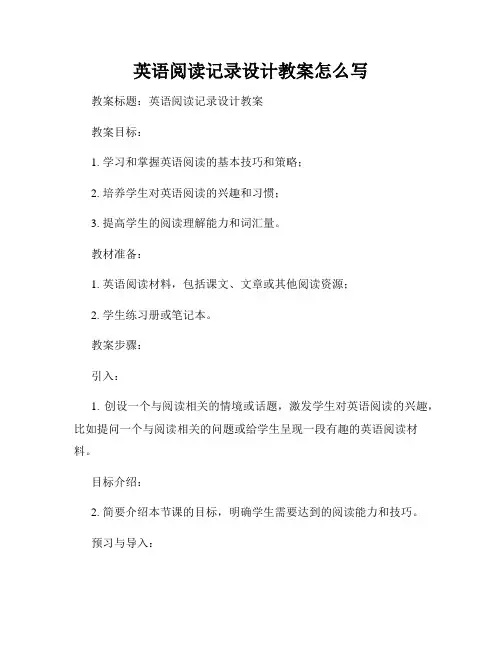
英语阅读记录设计教案怎么写教案标题:英语阅读记录设计教案教案目标:1. 学习和掌握英语阅读的基本技巧和策略;2. 培养学生对英语阅读的兴趣和习惯;3. 提高学生的阅读理解能力和词汇量。
教材准备:1. 英语阅读材料,包括课文、文章或其他阅读资源;2. 学生练习册或笔记本。
教案步骤:引入:1. 创设一个与阅读相关的情境或话题,激发学生对英语阅读的兴趣,比如提问一个与阅读相关的问题或给学生呈现一段有趣的英语阅读材料。
目标介绍:2. 简要介绍本节课的目标,明确学生需要达到的阅读能力和技巧。
预习与导入:3. 让学生进行预习,包括阅读本课的相关材料,并准备书面或口头的回答问题或进行讨论。
引导学生观察文本结构、关键词汇或其他阅读策略。
阅读技巧教学:4. 教授不同的阅读技巧和策略,如预测、扫读、细读、略读、推理等。
通过示范和实践指导学生如何运用这些技巧提高阅读效果。
阅读实践:5. 学生进行阅读实践,例如独立阅读指定的课文或文章,并根据教师提供的问题或任务进行理解和分析。
鼓励学生在阅读过程中做必要的笔记或标记,以便更好地理解和记忆。
记录设计:6. 指导学生如何设计自己的英语阅读记录。
提供一些记录模板或示例,包括标题、日期、阅读材料、主要内容摘要、生词整理等。
解释记录的目的和好处,鼓励学生坚持记录自己的阅读情况。
反馈与讨论:7. 教师与学生共同讨论阅读过程中遇到的问题、策略和收获。
鼓励学生分享自己的阅读记录,相互学习和提供反馈。
总结与延伸:8. 总结本节课的学习内容和重点,鼓励学生运用所学的阅读技巧继续拓展个人阅读习惯。
提供一些额外的阅读资源或活动,供学生在课外进行延伸学习。
作业布置:9. 布置适当的阅读作业,要求学生使用所学的阅读技巧阅读一篇自选的英语文章,并记录相关内容和收获。
教案评估:10. 通过学生的课堂表现、阅读记录和作业完成情况等方式进行教案评估。
教案扩展:11. 根据学生的学习情况调整教案,为下一节课的英语阅读教学做好准备。
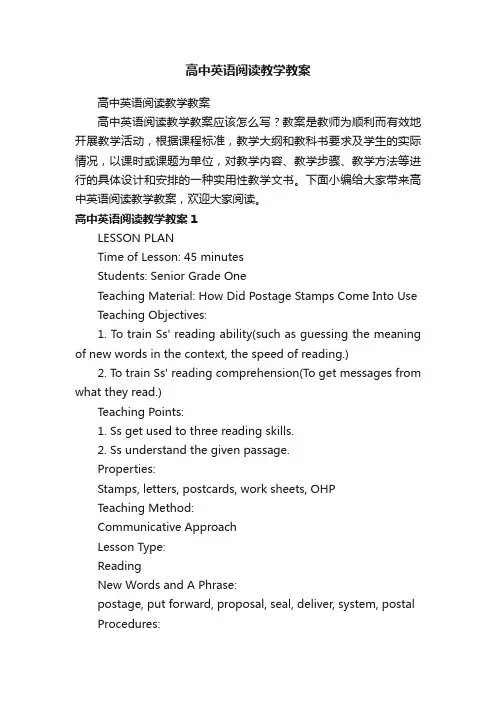
高中英语阅读教学教案高中英语阅读教学教案高中英语阅读教学教案应该怎么写?教案是教师为顺利而有效地开展教学活动,根据课程标准,教学大纲和教科书要求及学生的实际情况,以课时或课题为单位,对教学内容、教学步骤、教学方法等进行的具体设计和安排的一种实用性教学文书。
下面小编给大家带来高中英语阅读教学教案,欢迎大家阅读。
高中英语阅读教学教案1LESSON PLANTime of Lesson: 45 minutesStudents: Senior Grade OneTeaching Material: How Did Postage Stamps Come Into Use Teaching Objectives:1. To train Ss' reading ability(such as guessing the meaning of new words in the context, the speed of reading.)2. To train Ss' reading comprehension(To get messages from what they read.)Teaching Points:1. Ss get used to three reading skills.2. Ss understand the given passage.Properties:Stamps, letters, postcards, work sheets, OHPTeaching Method:Communicative ApproachLesson Type:ReadingNew Words and A Phrase:postage, put forward, proposal, seal, deliver, system, postal Procedures:Step 1. Warm-up(6')1. Lead-inShow some stamps, letters and postcards and have free talk to arouse students' motivation.2. Dealing with some new wordsQ: Do you know the postage of a letter?Explain "postage", and write postage on the Bb.postage: payment for the carrying of lettersA: Fifty fen for any place in China except Hong Kong, Taiwan and Macao.Q: What do the postmen do with the letters?A: They take the letters from the postbox and carry them away to the places on the envelopes and deliver them to the addressed people.Explain "deliver", and write deliver on the Bb.deliver: take letters or goods to the addressed people.Q: Who put forward the proposal to use stamps? Use OHP to project the question onto the screen.Explain "put forward" and "proposal", and write them on the Bb.put forward: put an idea before people for thinking overproposal: sth. proposed, plan or idea, suggestionAgain: Who put forward the proposal to use stamps?Step 2. Skimming(4'30")1. InstructionsT: Now I give you a passage to read, and for the first time you should only find the answer to the question. You have only two and a half minutes to read. So don't read word for word. Read quickly. Just try to find the answer.2. Handing out the reading material and readingQ: Who put forward the proposal to use stamps.A: Rowland Hill, a schoolmaster in England.Step 3. Scanning(6')1. InstructionsT: This time I give you three minutes to read the passage. When you are reading, find the answers to the two questions.Use OHP to project the questions:1. Why was the postage high in the early nineteenth century when people did not use stamps?2. When was postage stamps first put to use?2. Reading3. Checking1) Pair work2) Class checkingAns. to Que.1. Because the post offices had to send many people to collect the postage.Ans. to Que.2. On May 6, 1840.Step 4. Full reading(21')1. InstructionsT: Now I give you ten minutes to read the passage for the third time and you should read it carefully. Before reading, let's go over the questions on the work sheet.Give Work Sheet 1 to the Ss. Explain the new words in Que.4.prevent: stop, not let sb. do sth.reuse: use againT: Try to find the answers to the questions. But don't write the answers down, you can put a sign or underline the sentences concerning the questions.3. Checking1) Group work: Checking the answers in a group of four Ss.2) Class work: Checking the answers in class.Possible Answers:1. Why were people unhappy to pay postage for letters in the early nineteenth century?Because they had to pay postage when they received letters, especially when they paid for a letter which they did not wish to receive at all. The postage was high.2. Why was it much easier for people to use stamps for postage?Because people could go to the nearby post office to buy stamps and put them on envelopes before they sent the letters.3. Why was the postage much lower using stamps?Because in this way, the post office did not need to send postmen to collect postage. It only needed to send fewer postmen to deliver letters.4. How could the post office prevent people from reusing the stamps?The post office could simply put seals on the stamps so that people could not use the stamps again.Check the understanding of the word "seal", and write it on the Bb.seal: 邮戳5. Did other countries take up the new postal system?Yes.Check the understanding of "postal" and "system", and write them on the Bb.postal: of the postsystem: a set of working ways6. Does every country in the world has its own stamps?Yes.Step 5: Rounding-off(7')1. Answering Ss' questions on the passage if any.2. Making a guided-dialogue with the information given from the passage.Hand out Work Sheet 2. Do it in pairs.3. Asking two or three pairs to read their dailogues.A possible completed dialogue:A: Oh, What a beautiful stamp!B: Yes, it's from the U.S.A..A: Do you know in the early nineteenth century people did not use stamps?B: Then how did they pay the postage?A: They had to pay the postage when they received letters.B: Was the postage very high then?A: Yes. Because the post offices had to send many people to collect the postage.B: Who put forward the proposal to use stamps?A: Rowland Hill, a schoolmaster in England.B: Why do post offices put seals on the stamps?A: They can prevent people from using the stamps again.B: When did post offices begin to sell stamps?A: On May 6, 1840.B: Thank you for telling me so many things about stamps.Step 6. Assignment(30")Ask the Ss to shorten the passage within four or five sentences after class, and to write it in their exercise books.*************************************************************Reading Material:How Did Postage Stamps Come Into UseWhen you send a letter or a postcard, you have to put stamps on the envelope or on the card. When did people first begin to use stamps? Who was the first to think of this idea?In the early nineteenth century, people did not use stamps. They had to pay postage when they received letters. They were unhappy about this, especially when they paid for a letter which they did not wish to receive at all. The postage was high at that time, because the post offices had to send many people to collect the postage.Rowland Hill, a schoolmaster in England, was the first to put forward a proposal to use stamps. He thought it would be much easier for people to use stamps to cover postage. They could go to the nearby post office to buy stamps and put them on envelopes before they sent the letters. The post office could simply put seals on the stamps so that people could not use the stamps again. In this way, the post office did not need to send postmen to collect postage. It only needed to send fewer postmen to deliver letters. That was a good idea and the government finally accepted it.On May 6, 1840, post offices throughout England began to sell stamps. Soon this new postal system was taken up by other countries. Now each country has its own stamps. And there are many people who collect stamps all over the world.Work Sheet 1:Find the answers to the following questions from the passage:1. Why were people unhappy to pay postage for letters in the early nineteenth century?2. Why was it much easier for people to use stamps for postage?3. Why was the postage much lower using stamps?4. How could the post office prevent people from reusing the stamps?5. Did other countries take up the new postal system?6. Does every country in the world has its own stamps now?Work Sheet 2:Complete the dialogue with the information you have got: A: Oh, What a beautiful stamp!B: Yes, it's from the U.S.A..A: Do you know ____________________ people did not use stamps?B: Then how did they pay the postage?A: ___________________________________________________________.B: Was the postage very high then?A: ___________________________________________________________.B: Who put forward the proposal to use stamps?A: ___________________________________________________________.B: Why do post offices put seals on the stamps?A: ___________________________________________________________.B: When did post offices begin to sell stamps?A: ___________________________________________________________.B: Thank you for telling me so many things about stamps. 高中英语阅读教学教案2Module 7 Unit 4 SharingReading A Letter HomeⅠ.Teaching ContentsModule 7 Unit4 Sharing Reading: A Letter HomeII.Analysis of teaching material本单元的话题是Sharing,本课设计的这篇课文是一个志愿者的一封家书,她在巴布亚新几内亚共和国的一个小山村教书。
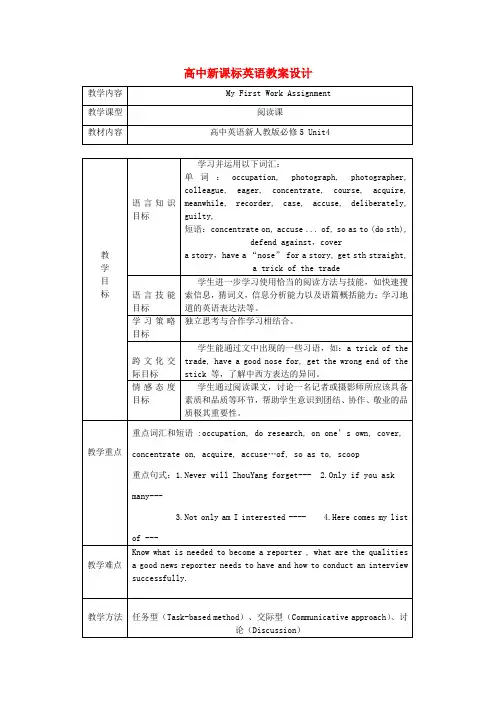
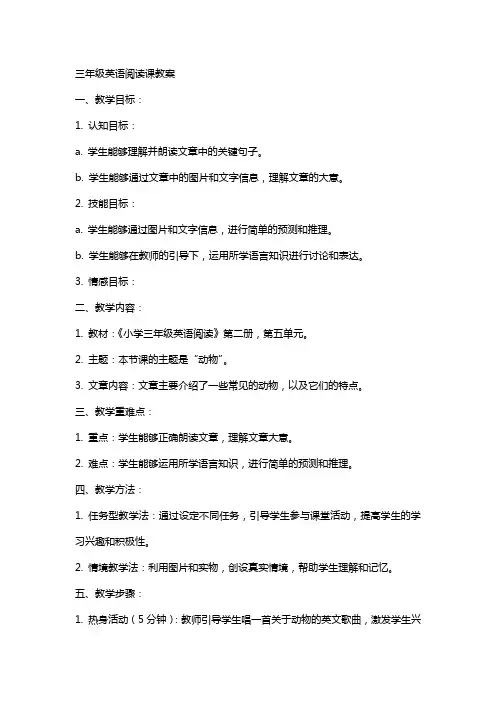
三年级英语阅读课教案一、教学目标:1. 认知目标:a. 学生能够理解并朗读文章中的关键句子。
b. 学生能够通过文章中的图片和文字信息,理解文章的大意。
2. 技能目标:a. 学生能够通过图片和文字信息,进行简单的预测和推理。
b. 学生能够在教师的引导下,运用所学语言知识进行讨论和表达。
3. 情感目标:二、教学内容:1. 教材:《小学三年级英语阅读》第二册,第五单元。
2. 主题:本节课的主题是“动物”。
3. 文章内容:文章主要介绍了一些常见的动物,以及它们的特点。
三、教学重难点:1. 重点:学生能够正确朗读文章,理解文章大意。
2. 难点:学生能够运用所学语言知识,进行简单的预测和推理。
四、教学方法:1. 任务型教学法:通过设定不同任务,引导学生参与课堂活动,提高学生的学习兴趣和积极性。
2. 情境教学法:利用图片和实物,创设真实情境,帮助学生理解和记忆。
五、教学步骤:1. 热身活动(5分钟):教师引导学生唱一首关于动物的英文歌曲,激发学生兴趣。
2. 导入(10分钟):教师通过展示一些动物的图片,引导学生说出这些动物的名称,为新课的学习做好铺垫。
3. 自主阅读(10分钟):学生自主阅读文章,理解文章内容。
教师巡回指导,解答学生的疑问。
4. 小组讨论(10分钟):学生分小组,讨论文章中的关键句子和难点词汇。
教师参与讨论,给予指导和帮助。
6. 作业布置:学生回家后,选择一篇自己喜欢的动物文章,进行阅读,并尝试画出文章中的动物。
六、教学评估:1. 课堂观察:教师在课堂上观察学生的参与程度、朗读流利程度以及对文章内容的理解情况。
2. 小组讨论:教师在学生小组讨论时,注意学生的表达能力和合作精神。
3. 作业完成情况:教师检查学生作业的完成质量,了解学生对课堂内容的掌握情况。
七、教学反思:1. 教师在课后对自己的教学进行反思,思考教学目标的达成情况,教学方法和教学内容的适用性。
2. 教师根据学生的反馈和自己的观察,调整教学策略,以提高教学效果。
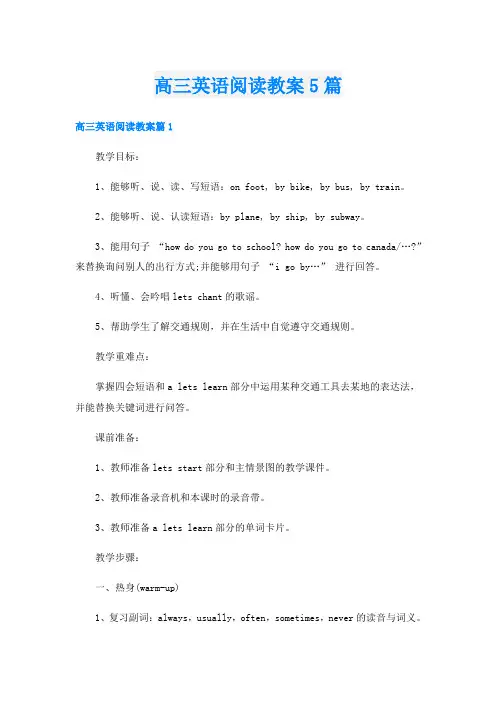
高三英语阅读教案5篇高三英语阅读教案篇1教学目标:1、能够听、说、读、写短语:on foot, by bike, by bus, by train。
2、能够听、说、认读短语:by plane, by ship, by subway。
3、能用句子“how do you go to school? how do you go to canada/…?”来替换询问别人的出行方式;并能够用句子“i go by…”进行回答。
4、听懂、会吟唱lets chant的歌谣。
5、帮助学生了解交通规则,并在生活中自觉遵守交通规则。
教学重难点:掌握四会短语和a lets learn部分中运用某种交通工具去某地的表达法,并能替换关键词进行问答。
课前准备:1、教师准备lets start部分和主情景图的教学课件。
2、教师准备录音机和本课时的录音带。
3、教师准备a lets learn部分的单词卡片。
教学步骤:一、热身(warm-up)1、复习副词:always,usually,often,sometimes,never的读音与词义。
t: when do you get up? / when do you go to school? … (引导学生用always,usually,often,sometimes回答)2、t:today i go to school by bus. i usually go to school on foot. 教师利用肢体动作帮助学生理解句子意思。
t:what about you? do you go by bike or by bus? do you go on foot? or by car? 师生之间自由会话,引出几种常见的交通方式。
引导学生看本课lets start部分的标图并回答问题。
二、预习(preview)1、lets chant教师放本课lets chant部分的录音,唱到on foot时,全班跺跺脚;唱到by car/ bike/ bus/ plane/ train的时候,学生做出相应的动作。
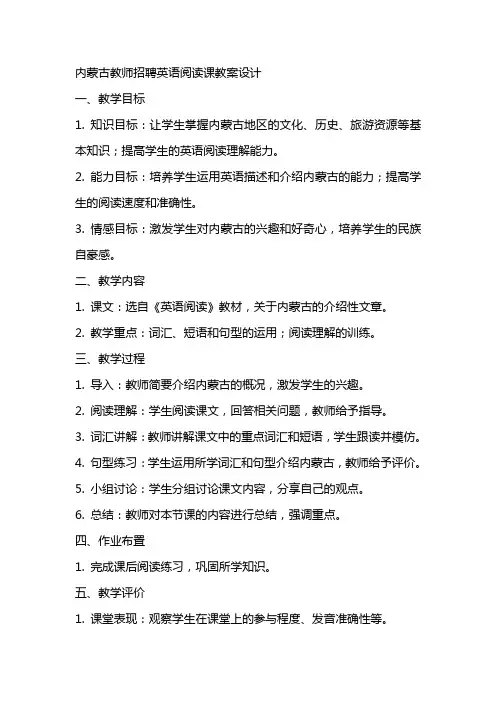
内蒙古教师招聘英语阅读课教案设计一、教学目标1. 知识目标:让学生掌握内蒙古地区的文化、历史、旅游资源等基本知识;提高学生的英语阅读理解能力。
2. 能力目标:培养学生运用英语描述和介绍内蒙古的能力;提高学生的阅读速度和准确性。
3. 情感目标:激发学生对内蒙古的兴趣和好奇心,培养学生的民族自豪感。
二、教学内容1. 课文:选自《英语阅读》教材,关于内蒙古的介绍性文章。
2. 教学重点:词汇、短语和句型的运用;阅读理解的训练。
三、教学过程1. 导入:教师简要介绍内蒙古的概况,激发学生的兴趣。
2. 阅读理解:学生阅读课文,回答相关问题,教师给予指导。
3. 词汇讲解:教师讲解课文中的重点词汇和短语,学生跟读并模仿。
4. 句型练习:学生运用所学词汇和句型介绍内蒙古,教师给予评价。
5. 小组讨论:学生分组讨论课文内容,分享自己的观点。
6. 总结:教师对本节课的内容进行总结,强调重点。
四、作业布置1. 完成课后阅读练习,巩固所学知识。
五、教学评价1. 课堂表现:观察学生在课堂上的参与程度、发音准确性等。
2. 阅读理解测试:评估学生的阅读理解能力。
3. 作业完成情况:检查学生的作业,评估学生的学习效果。
4. 学生自评:鼓励学生自我评价,反思学习过程。
六、教学策略1. 任务型教学法:通过完成各种任务,如阅读、讨论、写作等,激发学生的学习兴趣,培养学生的实践能力。
2. 交际法:教师与学生、学生与学生之间的互动,提高学生的口语表达能力和交际能力。
3. 情境教学法:创设真实的语言环境,让学生在情境中学习,提高学生的学习兴趣和积极性。
七、教学手段1. 多媒体教学:使用课件、视频等教学资源,丰富教学内容,提高学生的学习兴趣。
2. 实物教学:使用地图、图片等实物,帮助学生更好地理解课文内容。
3. 小组合作学习:鼓励学生分组讨论,培养学生的团队合作精神和沟通能力。
八、教学步骤1. 课前准备:教师准备课件、实物等教学资源,提前布置课堂。
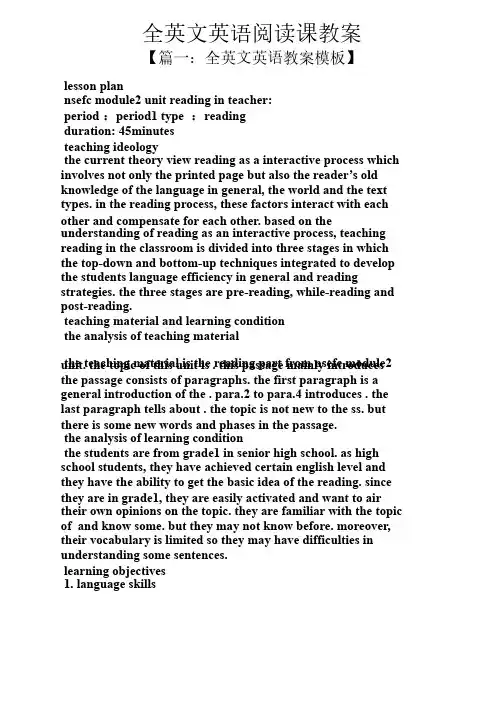
全英文英语阅读课教案【篇一:全英文英语教案模板】lesson plannsefc module2 unit reading in teacher:period:period1 type:readingduration: 45minutesteaching ideologythe current theory view reading as a interactive process which involves not only the printed page but also the reader’s old knowledge of the language in general, the world and the text types. in the reading process, these factors interact with each other and compensate for each other. based on the understanding of reading as an interactive process, teaching reading in the classroom is divided into three stages in which the top-down and bottom-up techniques integrated to develop the students language efficiency in general and reading strategies. the three stages are pre-reading, while-reading and post-reading.teaching material and learning conditionthe analysis of teaching materialthe teaching material is the reading part from nsefc module2 unit. the topic of this unit is . this passage mainly introduces the passage consists of paragraphs. the first paragraph is a general introduction of the . para.2 to para.4 introduces . the last paragraph tells about . the topic is not new to the ss. but there is some new words and phases in the passage.the analysis of learning conditionthe students are from grade1 in senior high school. as high school students, they have achieved certain english level and they have the ability to get the basic idea of the reading. since they are in grade1, they are easily activated and want to air their own opinions on the topic. they are familiar with the topic of and know some. but they may not know before. moreover, their vocabulary is limited so they may have difficulties in understanding some sentences.learning objectives1. language skillsat the beginning of the class, ss can predict the content ofthe passage based on the title. ? ss can scan the passage andfind out the specific information such as the person relatedwithss can summarize the passage with the help of the clues ofthe passage.2. language knowledgess can master the key words and phrases of the passage as follows, . ? ss can learn , especially3. affectsss will realize that and they will concern themselves with the issue of4. cultural awarenessss will broaden their minds by knowing something about 5. learning strategiesss will cultivate their ability individual learning and cooperative learning by doing someactivities independently and some in groups.ss will communicate with each other in english while doingthe group work.language difficultiesfocuses and anticipatedlanguage focusesthis is a reading period so the focus is to cultivate thestudents’ reading skills. the many activities are designed tohelp ss to train their reading skills, such as predicting, skimming, scanning and summarizing.it is also important for the ss to master the new words and phrases.anticipated difficultiesas the ss have a limited vocabulary, so they may have some difficulties in understanding the passage. so the teacher willhelp them learn the new words and phrases.ss may did not heard before, so the teacher will tell themsome background knowledge about it.teaching methodthree-stage model: based on the understanding of reading asan interactive process, teaching reading in the classroom is divided into three stages in which the top-down and bottom-up techniques integrated to develop the students languageefficiency in general and reading strategies. the three stagesare pre-reading, while-reading and post-reading.teaching aidsmultimedia devices and ppt documents: in order to help ss tofully understand the whole passage, i adopt multimediadevices and ppt documents to bring the real-life situation intothe classroom.teaching proceduresstep1. lead-in (6min)activity1. greetings and free-talking (2min)t leads into the topic by asking ss some they know. ss tell the name of the they know freely.t: hello boys and girls. (ss say hello to the teacher.)t: when we say , what appears in your minds? (ss tell thethings appear in their minds freely.) t: what are the ? (ss tell some names of .)activity2. picture-talking (4min)t shows some pictures about the in china and abroad. after seeing the pictures, ss are expected to tell the similarities of them.t: just now, you talk about some in china. now, let’s see some pictures of some . (t shows the pictures and ss see them carefully.)t: what do the have in common?for example, they are very precious. what are your opinions?(t gives them some hints and ss tell the characteristics of ) [aims]in this step, t first leads in the topic by talking with the ssfreely about the whichis familiar to them and then ss see some pictures and tell the characteristics. these two activities aim to arouse the ss’interests in the topic and activate their old knowledge of . thenss will be mentally prepared for the reading comprehension. what’s more,when they are talking about the charateristics of, they will realize that theare rare and precious and they will concern themselves with the issue of .step2. pre-reading (3min)activity1. knowing something about (1min)t gives a brief introduction of the. ss will know the t: today, weare going to learn . it is . do you know what is? (t shows some pictures ofand ss get to know the .)activity2. predicting (2min)t asks ss to read the title of the passage and then ask themsome questions. ss will predict the content of the passage withthe help of the title.t: please look at the title “”, what does “” mean?(if the ss can not give the answer, then t explain it.)t: in search means that people are looking for it. why arepeople looking for it? can you guess? what will the passagetalk about?(ss predict the content, but t will not give the answer here.)[aims]in this step, the ss first know some information of the ; the background information will make it easier for the ss tounderstand the passage. then t asks ss to make predictionsabout the passage. it aims to help ss develop the reading skillsof predicting.step3. while-reading (22min)activity1. skimming (4min)ss skim the whole passage and find out and check their predictions. t: why are people still ? here is a multiple choicefor you.activity2. scanning (3min)t presents several true or false statements and asks the ss toscan the passage and judge the right from the wrong.(keys: F,F,T,T,F)activity3 close-reading (15min)t designs various kinds of activities and ss do the activities tofully understand the passage. para.1t: please read para.1 carefully and then take some note aboutthe .para.2-4please read para.2-4 carefully and then find out the removal ofthe room.please read para.2-4 carefully and then find out the personrelated with the amber room and the things them down with it. para.5please read para.5 carefully and then find out the therebuilding of the amber room.【篇二:初中英语阅读课教学设计】谈初中英语阅读课教学案例吉林省桦甸市金沙中学:王欣平一、背景现行初中英语教材具有很多的优点,但由于学生认知水平的发展具有规律性,教师只有充分认识和掌握这种规律,并结合教学实际,合理设计教学程序,充分发挥学生的主体作用,教学相长,才能达到教学效果的最优化。
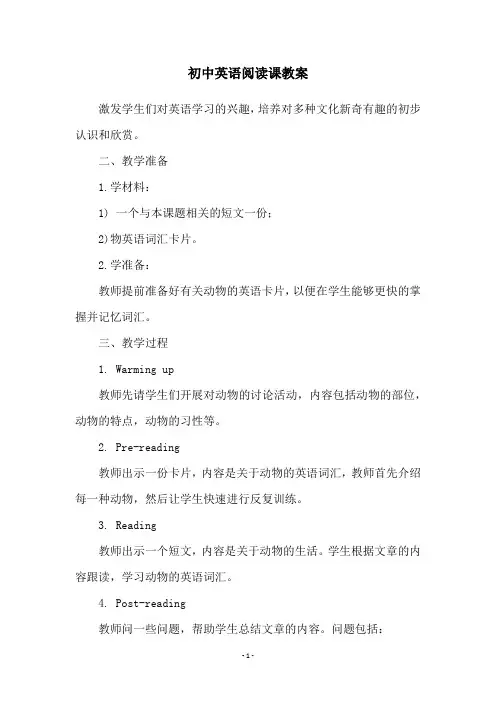
初中英语阅读课教案激发学生们对英语学习的兴趣,培养对多种文化新奇有趣的初步认识和欣赏。
二、教学准备1.学材料:1) 一个与本课题相关的短文一份;2)物英语词汇卡片。
2.学准备:教师提前准备好有关动物的英语卡片,以便在学生能够更快的掌握并记忆词汇。
三、教学过程1. Warming up教师先请学生们开展对动物的讨论活动,内容包括动物的部位,动物的特点,动物的习性等。
2. Pre-reading教师出示一份卡片,内容是关于动物的英语词汇,教师首先介绍每一种动物,然后让学生快速进行反复训练。
3. Reading教师出示一个短文,内容是关于动物的生活。
学生根据文章的内容跟读,学习动物的英语词汇。
4. Post-reading教师问一些问题,帮助学生总结文章的内容。
问题包括:What are the animals doing?They are eating, playing, sleeping……5. Homework教师要求学生根据文章内容,设计出一个游戏,练习动物英语单词。
四、设计意图该课程设计的意图在于通过让学生读一篇有关动物生活的短文,以及进行相关练习,培养学生对动物词汇的掌握,同时也能培养学生对文章内容的理解和总结能力。
中学英语课堂上,阅读课以其兴趣性、多样性和有趣性被视为教学重中之重。
而初中阶段的阅读课,更是年轻学生英语学习取得突破性进展的关键。
本文便以“初中英语阅读课教案”为题,分析了一节初中英语阅读课的教学内容与实施方案。
首先,针对该节课的教学目标,我们把语言知识目标定为:学习有关动物的英语词汇,掌握句型“What are they doing? They are…”;而情感态度价值观目标定为:激发学生们对英语学习的兴趣,培养对多种文化新奇有趣的初步认识和欣赏。
接着,按照相关的教学准备,需要准备教学材料和辅助教具,即一份与本课题相关的短文,以及与其相关的动物英语词汇卡片。
教师提前准备好它们,是为了便于学生能够更快的掌握并记忆词汇。
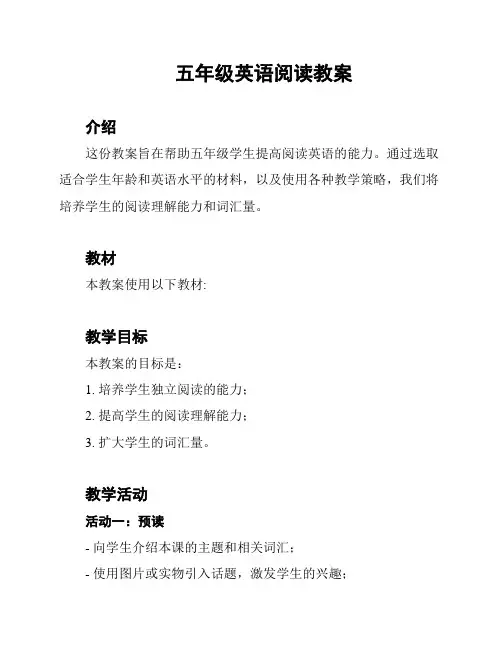
五年级英语阅读教案
介绍
这份教案旨在帮助五年级学生提高阅读英语的能力。
通过选取适合学生年龄和英语水平的材料,以及使用各种教学策略,我们将培养学生的阅读理解能力和词汇量。
教材
本教案使用以下教材:
教学目标
本教案的目标是:
1. 培养学生独立阅读的能力;
2. 提高学生的阅读理解能力;
3. 扩大学生的词汇量。
教学活动
活动一:预读
- 向学生介绍本课的主题和相关词汇;
- 使用图片或实物引入话题,激发学生的兴趣;
- 学生根据图片或标题预测课文内容。
活动二:阅读
- 学生独立阅读课文,鼓励他们尽量理解故事内容;
- 学生可以标记不懂的词汇或句子,并在阅读后解决疑惑。
活动三:阅读理解
- 提问学生关于课文内容的问题,检查他们的理解能力;- 鼓励学生通过回答问题来展示他们对故事的理解。
活动四:词汇扩展
- 引导学生研究新的词汇,包括关键词汇和课文中的生词;- 使用图片或例句帮助学生理解词汇的意思;
- 练使用这些词汇进行句子构建和对话。
活动五:小组讨论
- 学生分组,就课文中的某个话题展开讨论;
- 鼓励学生彼此交流,分享自己的想法和观点;
- 每个小组选择一名代表汇报他们的讨论成果。
评估与反馈
- 教师可以使用选择题、填空题或问答题来评估学生对课文的
理解;
- 教师应及时给予学生反馈,指导他们改正错误和提供更好的
答案。
总结
通过本教案的研究,五年级学生将提高阅读能力、扩大词汇量,并培养独立阅读的惯。
这将对他们未来的研究和英语能力的提升产
生积极影响。
一、教学目标1. 知识目标:学生能够掌握阅读技巧,提高阅读速度和准确率;理解并运用英语词汇、短语和句型;了解不同题材的英语文章特点。
2. 技能目标:培养学生阅读能力,包括快速阅读、精读、略读等;提高学生分析、归纳和总结的能力;提高学生英语口语和写作能力。
3. 情感态度价值观目标:激发学生对英语阅读的兴趣,培养良好的阅读习惯;提高学生的自信心,增强学习动力;培养学生的跨文化交际意识。
二、教学重难点1. 教学重点:阅读技巧、词汇理解、语法运用、文章结构分析。
2. 教学难点:快速阅读、精读、略读的区分与应用;长难句的分析与理解;不同题材文章的特点与阅读策略。
三、教学方法1. 讲授法:讲解阅读技巧、文章结构、语法知识等。
2. 案例分析法:通过分析典型文章,引导学生掌握阅读方法。
3. 小组讨论法:培养学生的合作精神和交流能力。
4. 任务型教学法:通过设计阅读任务,提高学生的阅读兴趣和参与度。
四、教学过程第一课时1. 导入新课- 通过提问,引导学生回顾已学过的阅读技巧,如略读、精读、快速阅读等。
- 介绍本节课的学习目标,激发学生的学习兴趣。
2. 阅读技巧讲解- 讲解略读、精读、快速阅读等阅读技巧,结合实例进行分析。
- 引导学生掌握不同阅读技巧的应用场景。
3. 课堂练习- 学生分组,进行阅读练习,教师巡回指导。
- 学生展示练习成果,教师点评并总结。
4. 总结与反馈- 对本节课所学内容进行总结,强调重点和难点。
- 鼓励学生在课后继续练习,提高阅读能力。
第二课时1. 导入新课- 回顾上一节课所学内容,检查学生对阅读技巧的掌握程度。
- 介绍本节课的学习目标,激发学生的学习兴趣。
2. 词汇讲解- 讲解本节课文章中的重点词汇,包括词义、用法、搭配等。
- 学生进行词汇练习,巩固所学词汇。
3. 阅读分析- 引导学生分析文章结构,了解文章主旨和段落大意。
- 学生分组讨论,分析文章中的语法、逻辑关系。
4. 课堂练习- 学生分组,进行阅读练习,教师巡回指导。
小学英语阅读课教案【篇一:小学英语阅读课教学设计】小学英语阅读课教学设计阅读课一直是小学英语教学中较难的一种课型,下面以牛津英语五年级教材内容my classmate, jim为例,谈一谈怎样从教材浅析,教学策略、教学流程和教学评价四个方面设计阅读课。
一、教材分析1、教学内容:本节课的主要话题是my classmate. 要求学生运用英语询问对方国籍,并就问题作出回答。
需要常握的词汇有:japan china englandjapanesechinese english需要掌握的句型有:wheres he/she/it from?is he/she/it/from……?本节教学内容综合了该单元的两种主要句型,以阅读小短文的形式出现,这体现了教材由易到难,循序渐进的原则。
2、教学目标新课程强调三维目标的统一,基于这个教学理念,并根据本课教学内容的特点和学生现有的认知水平,我确立了如下教学目标。
①掌握表示国家名称词汇,能运用句型询问他人来自何方,并对该询问做出回应。
②在准确朗读课文的基础上理解并复述课文。
③了解中西方的文化标志差异,培养学生的世界意识。
3、重点、难点重点:掌握本课的新单词和重点句型。
难点:学生能正确表述国籍,理解并复述课文。
二、教学策略为了达成以上教学目标,突破本课的教学重点和难点,我采用了如下教学策略。
1、学情分析《新英语课程标准》明确规定小六年级学生阅读要求,能借助图片读懂简单的故事或小短文,并养成按意群阅读的习惯,因此,本节课要把激发学生阅读兴趣,培养他们的阅读习惯,提高学生的阅读能力作为本堂课的主要宗旨。
2、教学手段为了服务这一宗旨,提高教学效益,我采用了多媒体课件、图片、录音机等辅助教学,以此来促进学生语言表达能力的提高和发展。
3、教学方法根据新课改的要求,为了让教学回归生活,建立起良好的课堂教学生态,为学生搭建开放性、平等性学习平台,让他们在快乐中学习和体验,我在教学中以任务型教学为纲,通过看图理解、朗读感悟,图片介绍,合作表演等方法启发,诱导学生理解、掌握本节内容。
高中英语阅读理解题教案_高中英语阅读教案高中英语教案应当怎么写呢,详细来讲一份正规的高中英语教案应当是怎样一种格式呢,想要知道的抓紧往下看。
下面是高中英语教案的格式,供广阔的教师参考。
一、教材分析:Analysis of the Teaching material二、教学目标:Teaching alms and demands:三、教学重难点:Teaching keys and difficulties:四、教学方法:Teaching methods:五、教学工具:Teaching aids:六、教学过程:Teaching procedures:七、板书设计:Blackboard Design.八教学评价与反思一份正规的高中英语教案主要应当包含上面的八个要点,也是作为一份教案应当具有的根本格式。
高中英语《A Master of Nonverbal Humor》教案Teaching goals:1. The students will be able to know some words and expressionsto describe a person’s appearance.2. The students will be able to know something about Charlie Chaplin’s life experiences, charming character and convincing performance.3. The students will be able to further understand the meaning of laughter.4. The students will be able to have a better command of summarizing a short passage by picking out key words from the passage.5. The students will be able to master a framework of introducing a person.6. The students will experience the reading strategy of summarizing, analyzing, inferring, and evaluating.Teaching process:Step 1: lead-inHave a taste of English humor by introducing two letters between Albert Einstein and Charlie Chaplin.Albert Einstein:You are really great. Everyone understands your film although there is no line.Charlie Chaplin:You are even greater although nobody understands your theory.设计意图:教师用简短的语言概括了爱因斯坦和卓别林之间的一次书信交往。
英语阅读课后服务教案 一、教材内容分析 本课是第六单元第三话题的Section C, 本话题以问路、指路为主,贯穿交通规则、交通标志、交通设施等常识性的知识,让学生在掌握问路这一 功能用语的同时,学会交通法则。知识循序渐进,环环紧扣,集实用性、生活性、趣味性于一体,充满了真切的生活信息,Section C以短文阅读为主,让学生掌握交通规则,加强交通安全防范意识。 二、教学目标(知识,技能,情感态度、价值观) (1) 文化知识目标: 熟练掌握与“交通规则”相关的常用词汇及主要语言表达形式。get hurt, lose one' s life, traffic accident, obey the traffic rules, cross the road, look right, look left it’s good to--- 学习析使句的肯定与否定形式, (2)能力目标 1)培养学生阅读能力。 2)通过小组活动,培养学生合作学习的能力。 (3)情感目标 1)通过文中帮助老人小孩过马路的情节,鼓励学生助人为乐; 2)通过对交通知识的学习,提醒学生注意遵守交通规则,加强交通安全防范意 识 三、学习者特征分析 本课的对象为七年级学生,他们学习英语时间不长,英语基础和阅读能力相对 薄弱,而且学生素质参差不齐,所以本课的顺利开展需要学生课前充分的预 习。同时七年级学生又是活泼好动的,图片动画便于引起他们的注意,课上需要充分通过图片动画及各种活动调动他们的学习积极性,激发学习兴趣,才能取得较好的学习效果。 四、教学策略选择与设计 (1)自主学习策略:学生通过自己独立解决教师提供的问题,通过自主阅读SectionC文章内容,完成文后题目。 (2)合作探究式学习策略:通过交通规则的学习,让学生分小组讨论,交流,引申到用英语祈使句制定班级规则,增强实际应用能力 (3)情景创设策略:为了激发学生的学习兴趣,运用生活中与教学内容相关的情景和大量flash动画来设计问题,组织教学内容,提出有启发性的引申间题,让学生把课堂英语学习带人生活中,积极应用英语。 (4) .课堂竞赛策略:教师设计比赛,调动学生学习积极性,检测学生掌握情况,及时肯定鼓励学生的优秀表现。 五、教学环境及资源准备 仁爱版教材七年级下册 录音机,小黑板 专门为本课设计的多媒体课件 多媒体教室。 六、教学过程
课时:2课时教学目标:1. 培养学生阅读英文文学作品的能力,提高阅读理解水平。
2. 引导学生了解海明威的文学风格和思想内涵。
3. 培养学生对海洋文化和渔民生活的关注。
教学重点:1. 理解《老人与海》的故事情节和人物性格。
2. 分析海明威的写作风格和象征手法。
3. 了解海洋文化和渔民生活。
教学难点:1. 理解海明威的象征手法。
2. 分析作品中的人物性格特点。
教学过程:第一课时一、导入1. 引导学生回顾之前学过的海明威作品,如《太阳照常升起》、《永别了,武器》等。
2. 介绍《老人与海》的背景和作者海明威。
二、阅读与理解1. 学生阅读课文,了解故事情节和人物性格。
2. 小组讨论,分析以下问题:(1)老人圣地亚哥为什么要出海捕鱼?(2)马诺林为什么离开老人?(3)老人与鲨鱼搏斗的经过如何体现他的勇敢和坚韧?三、写作风格分析1. 引导学生分析海明威的写作风格,如简洁的语言、直接的表达、象征手法的运用等。
2. 学生举例说明作品中的象征手法,如大海象征人生、鲨鱼象征命运等。
第二课时一、复习与巩固1. 回顾第一课时学习的内容,检查学生对故事情节和人物性格的理解。
2. 学生分享自己在阅读过程中的感受和收获。
二、讨论与分析1. 讨论以下问题:(1)老人圣地亚哥的性格特点有哪些?(2)海明威通过老人与海的对比,表达了怎样的思想?(3)作品中的海洋文化和渔民生活有哪些特点?2. 学生分组讨论,分享自己的观点和看法。
三、总结与拓展1. 总结《老人与海》的主题思想和文学价值。
2. 引导学生关注海洋文化和渔民生活,提高环保意识。
教学评价:1. 学生在阅读过程中,能理解故事情节和人物性格。
2. 学生能分析海明威的写作风格和象征手法。
3. 学生能关注海洋文化和渔民生活,提高环保意识。
教学反思:本节课通过阅读《老人与海》,引导学生了解海明威的文学风格和思想内涵,培养学生的阅读理解能力和文学鉴赏能力。
在教学过程中,注重学生的参与和互动,提高学生的自主学习能力。
)))))) 英語閱讀教學教案與活動設計 (Lesson Plans and Activities in Teaching Reading)
一. 前言 (Introduction) The goal of teaching reading is not just to facilitate students to understand the texts in the classroom. Teachers also need to instruct students how to approach and consider different types of texts. These reading skills and strategies can help students become independent and effective readers and continue to read beyond the classroom. The carryover is more important and useful for students in real life. However, teachers in Taiwan usually spend too much time in interpreting the texts in order to make students understand the texts. For gifted students, interpreting the texts is not enough. Teachers must be more creative and provide them opportunities to try predicting the contents and inferring the meanings and structures of the texts. Through these ways, gifted students can experience using different reading skills to approach and explore diverse texts, can acquire better reading comprehension and will be able to read independently and actively. In the book “Developing Reading Skills”, Grellet ( 2003) describes and classifies a lot of various types of reading comprehension activities and exercises to develop students' different reading skills, like skimming, scanning, anticipation, predicting, inference and reference skills. The book can give teachers many ideas when they design reading activities and worksheets. The following lesson plans are some examples for gifted students to practice different reading skills. The procedure will follow three stages: pre-reading, while-reading and post-reading and the subject is the friendly city-Kaohsiung. Based on students' needs and competence, teachers can adapt these examples and design more creative exercises and activities for their gifted students. Through the reading instruction, gifted students will be able to apply )))))s ))))))
suitable reading skills, comprehend different texts effectively and read texts more independently and actively. 對於資優學生而言,英語閱讀教學的目的不只是老師在課堂上幫助他們理解文章內容和增加文章內容的深度與廣度,老師更需要引導學生善用閱讀技巧和策略,以使他們在課堂外也能有效率地進入和探索不同類型的文章。閱讀技巧和策略的培養可以增強資優學生對文章內容的理解能力,並可以使他們成為獨立自主和主動的閱讀學習者,有助於他們獲取高深廣博的知識。 在「發展閱讀技巧」一書中,Grellet ( 2003)介紹了許多不同類型的閱讀理解活動
以發展各種閱讀技巧(如預測、參與、略讀、精讀、推論、歸納…..等),老師在設計閱讀活動和學習單時可加以參考。以下所列舉的教案所包含的活動和學習單將依照閱讀教學活動三階段(閱讀前、閱讀中、閱讀後),並針對不同的閱讀技巧來設計。希望透過這些閱讀活動和學習單的實施,資優學生能靈活運用實用的閱讀技巧,有效率地理解和吸收更廣更深的資料與文章。
本閱讀教案和活動設計的主題是:友善的都市-高雄。老師們可以參考這些活動設計範例,並根據學生的需要與能力加以改編,以進行更有效的英語閱讀教學。
*參考書目 (Reference): Grellet, F. (2003). Developing reading skills. Cambridge, UK: Cambridge University Press.
(Lesson Plans and Worksheets)教案與學習單二.
*Objectives: (1) Students will be able to use the title and pictures to get an idea about what the reading text is about. (2) Students will be able to point out the main idea by skimming through the text. (3) Students will be able to find out specific information from the text by )))))s ))))))
scanning. (4) Students will be able to identify and summarize the main points from the text. *Proficiency level: intermediate *Skills involved: anticipation / predicting / skimming / scanning / summarizing skills *Materials: pictures, worksheets, posters *Time: 45 minutes *Procedure: 1. Pre-reading (5 minutes) (1) Show some pictures of the tourist sites in Kaohsiung, and ask students to guess which tourist sites they are and to match the pictures and the Worksheet 1). names of the tourist sites(See
(2) Present the title of the reading passages “Top Picks in Kaohsiung” and ask students what the reading passages are about. 2. While-reading (10 minutes) (1) Students skim through the passages and try to find the main idea. Ask Worksheet 2).
students some questions about the main ideas(See (2) Students read the story again, but read carefully this time. They need Worksheet 3. to find specific information and fill in the table in
3. Post-Reading (30 minutes) Worksheet 2 (10 Activity One ( pair work ) - Answer the questions in ◎
minutes). Worksheet 3 (10 Activity Two- Do after reading the passages carefully